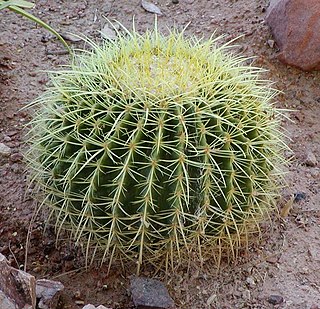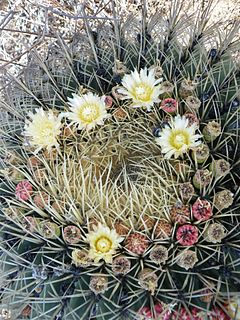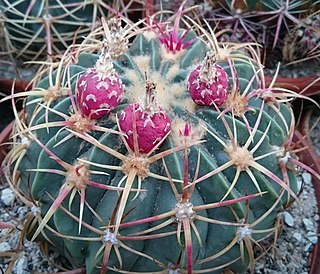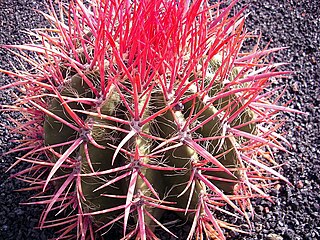
Barrel cacti are various members of the two genera Echinocactus and Ferocactus, found in the deserts of Southwestern North America. Some of the largest specimens can be found in the Mojave Desert in southern California.

Ferocactus is a genus of large barrel-shaped cacti, mostly with large spines and small flowers. There are about 30 species included in the genus. They are found in the southwestern United States and northwestern Mexico.

Tricholoma equestre or Tricholoma flavovirens, also known as man on horseback or yellow knight is a formerly widely eaten but hazardous fungus of the genus Tricholoma that forms ectomycorrhiza with pine trees.

The yellow-green tanager is a species of bird in the family Thraupidae. It is also known as the yellow-green bush tanager as it was formerly place in the genus Chlorospingus with other bush tanagers. The whole genus was moved to the New World sparrow family Passerellidae when bush tanagers were found to be more closely related to the genus Arremonops. However, recent molecular analysis has discovered that this species is neither a bush tanager or sparrow and the species returned to Thraupidae and placed in the genus Bangsia. It is found in Colombia and Ecuador. Its natural habitats are subtropical or tropical moist lowland forest and subtropical or tropical moist montane forest. It is threatened by habitat loss

Ferocactus cylindraceus is a species of barrel cactus which is known by several common names, including California barrel cactus, Desert barrel cactus, and miner's compass. It was first described by George Engelmann in 1853.

Ferocactus latispinus is a species of barrel cactus native to Mexico. Originally described as Cactus latispinus in 1824 by English naturalist Adrian Hardy Haworth, it gained its current name in 1922 with the erection of the genus Ferocactus by American botanists Britton and Rose. The species name is derived from the Latin latus "broad", and spinus "spine". Ferocactus recurvus is a former name for the species.

Ferocactus peninsulae is a barrel cactus in the genus Ferocactus of the family Cacteae.

Ferocactus emoryi, known commonly as Emory's barrel cactus, Coville's barrel cactus and traveler's friend, is a barrel cactus in the genus Ferocactus.
Streptomyces flavovirens is a bacterium species from the genus of Streptomyces which has been isolated from soil. Streptomyces flavovirens produces the actinomycin complex and mureidomycin. A strain of this species has been used to produce pravastatin.

Ferocactus alamosanus is a species of Ferocactus from Mexico. The specific epithet, alamosanus, refers to the plant's occurrence at Álamos in the Mexican state of Sonora, in northwestern Mexico.

Ferocactus chrysacanthus is a species of Ferocactus from Mexico.

Ferocactus diguetii is a species of Ferocactus from Mexico.

Ferocactus gracilis is a species of Ferocactus from Mexico.

Ferocactus townsendianus is a species of Ferocactus from Mexico.

Ferocactus santa-maria is a species of Ferocactus from Mexico.

Ferocactus schwarzii is a species of Ferocactus from Mexico.

Ferocactus pottsii is a species of Ferocactus from Mexico. The specific epithet has also been spelt pottsi.

Ferocactus histrix is a species of Ferocactus from Mexico.

Ferocactus macrodiscus is a species of Ferocactus from Mexico.

Ferocactus haematacanthus is a species of Ferocactus from Mexico.



















